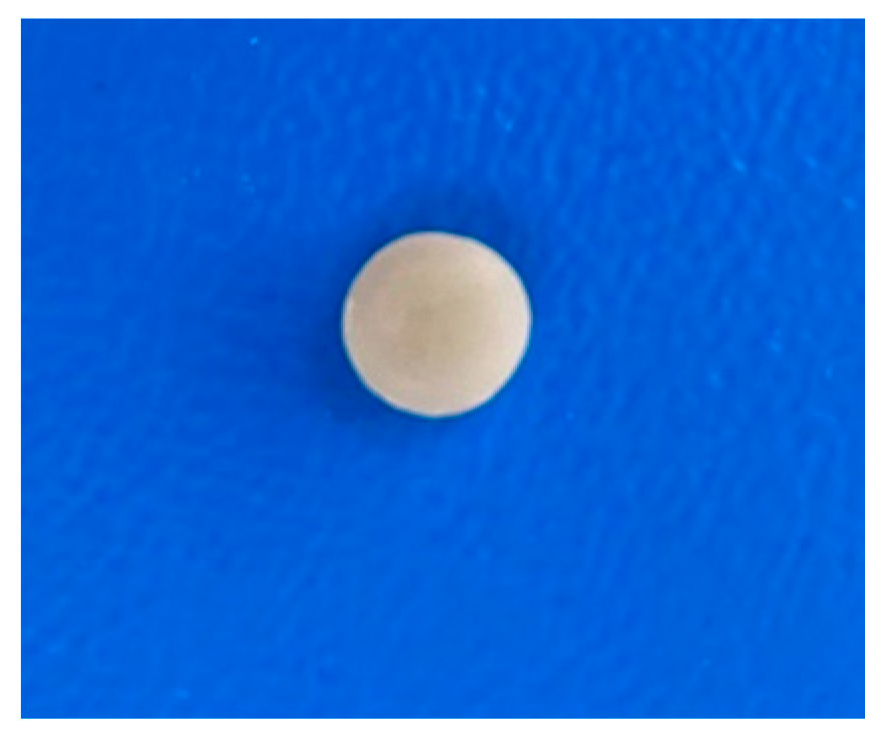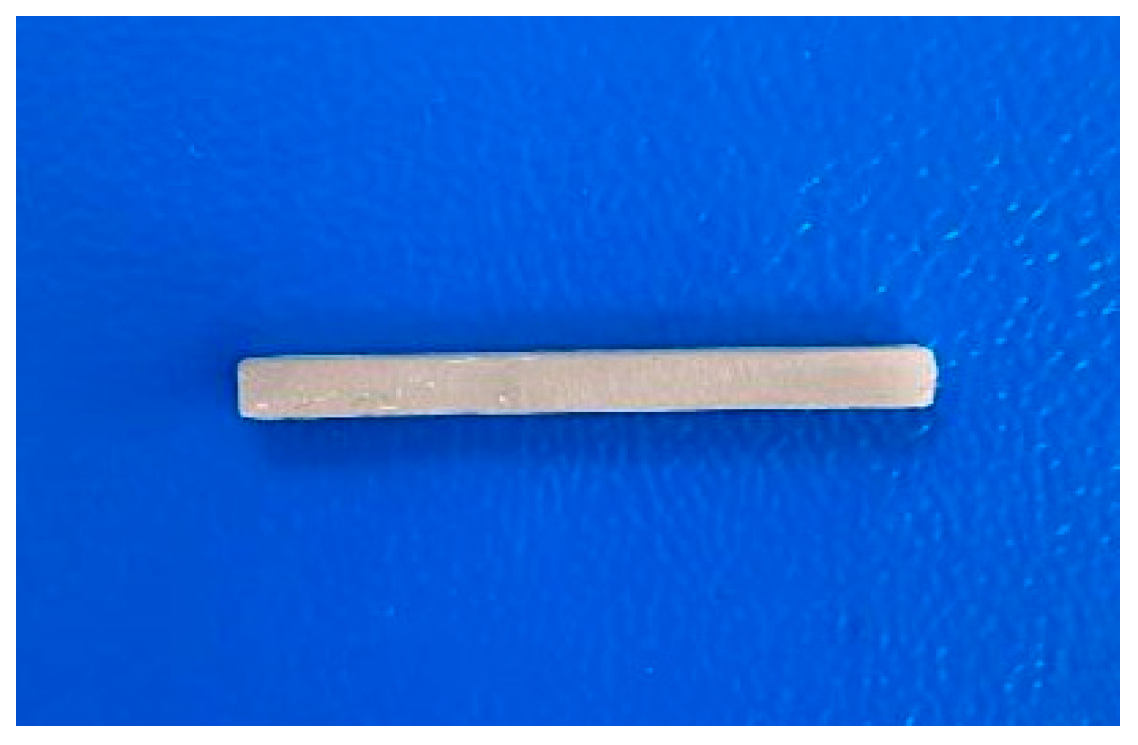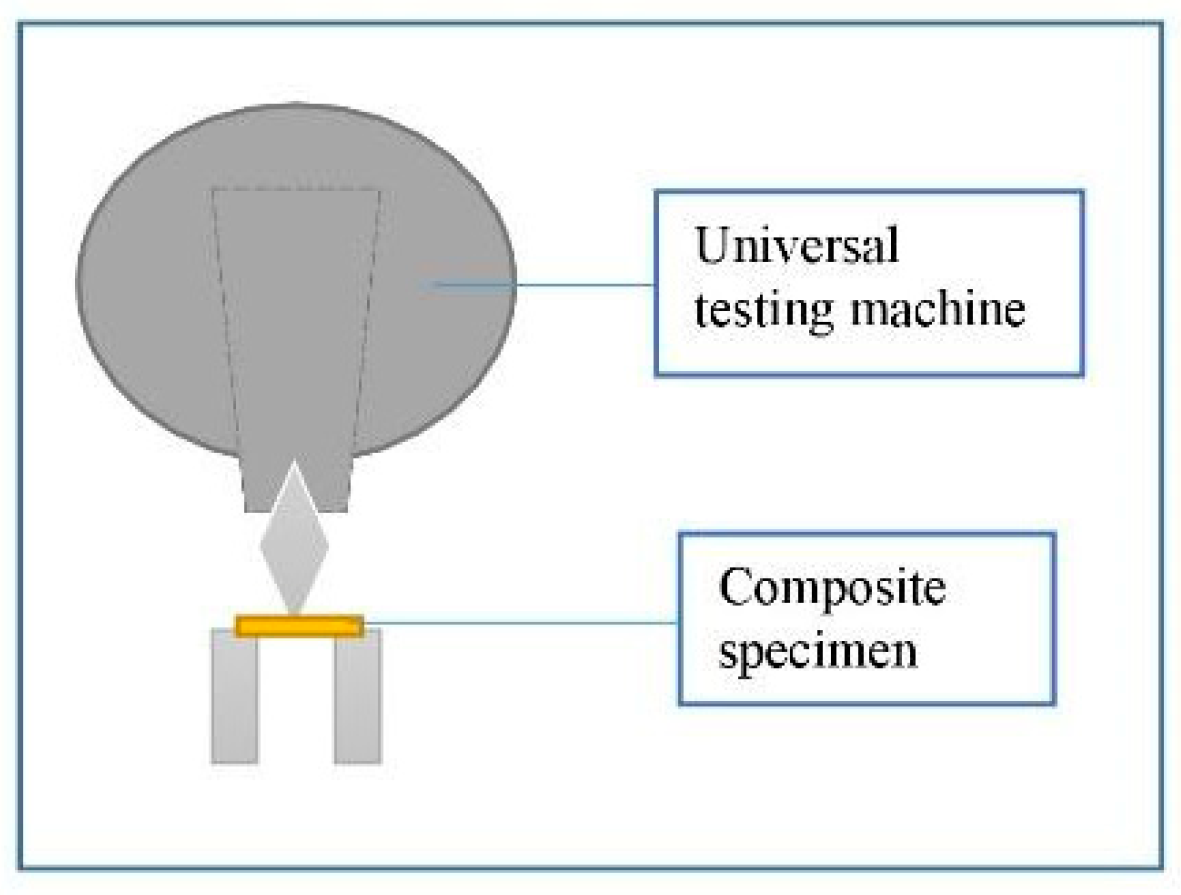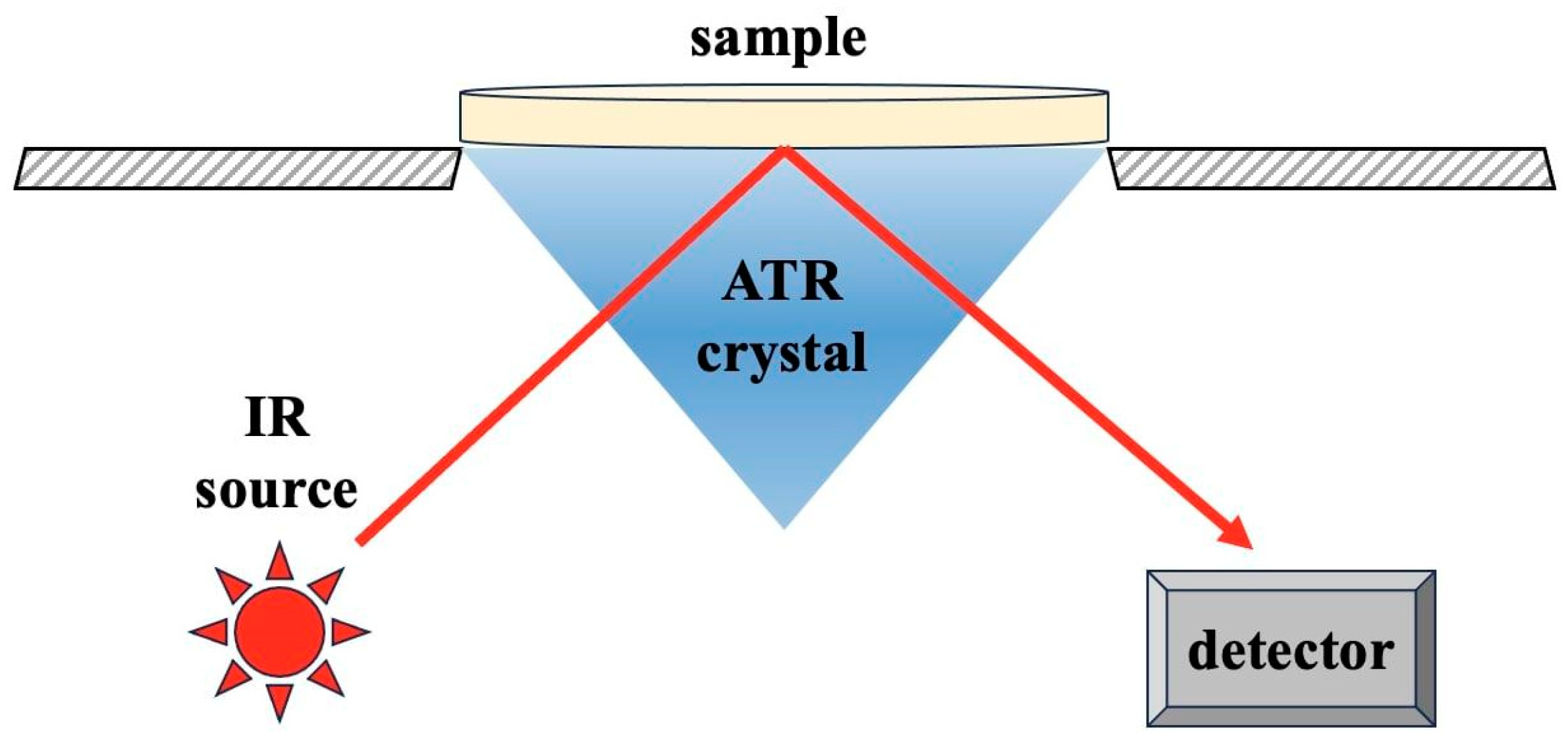Comparison of a Nanofiber-Reinforced Composite with Different Types of Composite Resins
Abstract
:1. Introduction
2. Materials and Methods
2.1. Sample Size Calculation
2.2. Microhardness Measurements
2.3. Flexural Strength and Modulus Elasticity Measurements
2.4. Volumetric Polymerization Shrinkage (VPS) Measurements by AcuVol Video Image Analysis
2.5. Degree of Conversion (DC) Measurements
2.6. Statistical Analysis
3. Results
3.1. Microhardness Measurements
3.2. Flexural Strength and Modulus Elasticity Measurements
3.3. VPS Measurement by AcuVol Video Image Analysis
3.4. DC Measurements
3.5. Linear Correlation between Physical and Mechanical Properties and Inorganic Filler Content
4. Discussion
5. Conclusions
Author Contributions
Funding
Institutional Review Board Statement
Data Availability Statement
Acknowledgments
Conflicts of Interest
References
- Da Rosa Rodolpho, P.A.; Rodolfo, B.; Collares, K.; Correa, M.B.; Demarco, F.F.; Opdam, N.J.; Cenci, M.S.; Moraes, R.R. Clinical performance of posterior resin composite restorations after up to 33 years. Dent. Mater. 2022, 38, 680–688. [Google Scholar] [CrossRef]
- Xu, T.; Li, X.; Wang, H.; Zheng, G.; Yu, G.; Wang, H.; Zhu, S. Polymerization shrinkage kinetics and degree of conversion of resin composites. J. Oral Sci. 2020, 62, 275–280. [Google Scholar] [CrossRef] [PubMed]
- Garoushi, S.; Vallittu, P.K.; Watts, D.C.; Lassila, L.V. Polymerization shrinkage of experimental short glass fiber-reinforced composite with semi-inter penetrating polymer network matrix. Dent. Mater. 2008, 24, 211–215. [Google Scholar] [CrossRef] [PubMed]
- Yadav, R.; Kumar, M. Dental restorative composite materials: A review. J. Oral Biosci. 2019, 61, 78–83. [Google Scholar] [CrossRef]
- Lins, R.; Vinagre, A.; Alberto, N.; Domingues, M.F.; Messias, A.; Martins, L.R.; Nogueira, R.; Ramos, J.C. Polymerization Shrinkage Evaluation of Restorative Resin-Based Composites Using Fiber Bragg Grating Sensors. Polymers 2019, 11, 859. [Google Scholar] [CrossRef]
- Shah, P.K.; Stansbury, J.W. Photopolymerization shrinkage-stress reduction in polymer-based dental restoratives by surface modification of fillers. Dent. Mater. 2021, 37, 578–587. [Google Scholar] [CrossRef] [PubMed]
- Ilie, N.; Hickel, R. Investigations on a methacrylate-based flowable composite based on the SDR™ technology. Dent. Mater. 2011, 27, 348–355. [Google Scholar] [CrossRef]
- Zandinejad, A.; Atai, M.; Pahlevan, A. The effect of ceramic and porous fillers on the mechanical properties of experimental dental composites. Dent. Mater. 2006, 22, 382–387. [Google Scholar] [CrossRef]
- Lassila, L.; Keulemans, F.; Vallittu, P.K.; Garoushi, S. Characterization of restorative short-fiber reinforced dental composites. Dent. Mater. J. 2020, 39, 992–999. [Google Scholar] [CrossRef]
- Garoushi, S.; Säilynoja, E.; Vallittu, P.K.; Lassila, L. Physical properties and depth of cure of a new short fiber reinforced composite. Dent. Mater. 2013, 29, 835–841. [Google Scholar] [CrossRef]
- Yancey, E.; Lien, W.; Nuttall, C.; Brewster, J.; Roberts, H.; Vandewalle, K. Properties of a New Nanofiber Restorative Composite. Oper. Dent. 2019, 44, 34–41. [Google Scholar] [CrossRef]
- Osiewicz, M.A.; Werner, A.; Roeters, F.J.; Kleverlaan, C.J. Wear of bulk-fill resin composites. Dent. Mater. 2022, 38, 549–553. [Google Scholar] [CrossRef] [PubMed]
- Ilie, N.; Kreppel, I.; Durner, J. Effect of radical amplified photopolymerization (RAP) in resin-based composites. Clin. Oral Investig. 2014, 18, 1081–1088. [Google Scholar] [CrossRef] [PubMed]
- Özduman, Z.C.; Kazak, M.; Fildisi, M.A.; Özlen, R.H.; Dalkilic, E.; Donmez, N. Effect of Polymerization Time and Home Bleaching Agent on the Microhardness and Surface Roughness of Bulk-Fill Composites: A Scanning Electron Microscopy Study. Scanning 2019, 2019, 2307305. [Google Scholar] [CrossRef]
- ISO-Standards 2009; ISO 4049 Dentistry-Polymer-Based Restorative Materials Geneve. International Organization for Standardization: London, UK, 2009.
- Askeland, D.R. The Science and Engineering of Materials; Springer Science Business Media: New York, NY, USA, 1996; ISBN 978-1-4899-2895-5. [Google Scholar] [CrossRef]
- Borges, B.C.D.; Groninger, A.I.S.; Soares, G.P.; dos Santos-Daroz, C.B.; Ambrosano, G.M.B.; Marchi, G.M.; Giorgi, M.C.C.; Aguiar, F.H.B. Curing Quality of Composites as Influenced by the Filler Content, Light Source and Curing Time. Dentistry 2012, 1, 103. [Google Scholar] [CrossRef]
- Kim, K.-H.; Ong, J.L.; Okuno, O. The effect of filler loading and morphology on the mechanical properties of contemporary composites. J. Prosthet. Dent. 2002, 87, 642–649. [Google Scholar] [CrossRef]
- Mccabe, J.F.; Wassell, R.W. Hardness of model dental composites—The effect of filler volume fraction and silanation. J. Mater. Sci. Mater. Med. 1999, 10, 291–294. [Google Scholar] [CrossRef]
- Alshabib, A.; Silikas, N.; Watts, D.C. Hardness and fracture toughness of resin-composite materials with and without fibers. Dent. Mater. 2019, 35, 1194–1203. [Google Scholar] [CrossRef]
- Wang, R.; Habib, E.; Zhu, X. Evaluation of the filler packing structures in dental resin composites: From theory to practice. Dent. Mater. 2018, 34, 1014–1023. [Google Scholar] [CrossRef] [PubMed]
- Uyar, T.; Çökeliler, D.; Doğan, M.; Koçum, I.C.; Karatay, O.; Denkbaş, E.B. Electrospun nanofiber reinforcement of dental composites with electromagnetic alignment approach. Mater. Sci. Eng. C 2016, 62, 762–770. [Google Scholar] [CrossRef]
- Catelan, A.; Mainardi, M.D.C.A.J.; Soares, G.P.; de Lima, A.F.; Ambrosano, G.M.B.; Lima, D.A.N.L.; Marchi, G.M.; Aguiar, F.H.B. Effect of light curing protocol on degree of conversion of composites. Acta Odontol. Scand. 2014, 72, 898–902. [Google Scholar] [CrossRef] [PubMed]
- Heintze, S.D.; Zimmerli, B. Relevance of in vitro tests of adhesive and composite dental materials, a review in 3 parts. Part 1: Approval requirements and standardized testing of composite materials according to ISO specifications. Schweiz. Monatsschrift Fur Zahnmed. 2011, 121, 804–816. [Google Scholar]
- Eweis, A.; Yap, A.; Yahya, N. Comparison of Flexural Properties of Bulk-fill Restorative/Flowable Composites and Their Conventional Counterparts. Oper. Dent. 2020, 45, 41–51. [Google Scholar] [CrossRef] [PubMed]
- Chung, S.; Yap, A.U.J.; Chandra, S.P.; Lim, C.T. Flexural Strength of Dental Composite Restoratives: Comparison of Biaxial and Three-Point Bending Test. J. Biomed. Mater. Res. 2004, 71, 278–283. [Google Scholar] [CrossRef]
- Suzaki, N.; Yamaguchi, S.; Hirose, N.; Tanaka, R.; Takahashi, Y.; Imazato, S.; Hayashi, M. Evaluation of physical properties of fiber-reinforced composite resin. Dent. Mater. 2020, 36, 987–996. [Google Scholar] [CrossRef]
- Bijelic-Donova Uctaslı, S.; Vallittu, P.K.; Lassila, L.V.J. Short fiber based filling composites original and repair bulk fracture resistance of particle filler and short fiber-reinforced composites. Oper. Dent. 2018, 43, E232–E242. [Google Scholar] [CrossRef]
- Vallittu, P.K. High-aspect ratio fillers: Fiber-reinforced composites and their anisotropic properties. Dent. Mater. 2015, 31, 1–7. [Google Scholar] [CrossRef]
- Van Ende, A.; De Munck, J.; Van Landuyt, K.L.; Poitevin, A.; Peumans, M.; Van Meerbeek, B. Bulk-filling of high C-factor posterior cavities: Effect on adhesion to cavity-bottom dentin. Dent. Mater. 2013, 29, 269–277. [Google Scholar] [CrossRef]
- Lee, J.H.; Um, C.M.; Lee, I.B. Rheological properties of resin composites according to variations in monomer and filler composition. Dent. Mater. 2006, 22, 515–526. [Google Scholar] [CrossRef]
- Oglakci, B.; Halacoglu, D.M.; Özduman, Z.C.; Dalkilic, E.E. Volumetric change and gap formation in class V composite restorations: A micro-CT analysis. J. Adhes. Sci. Technol. 2020, 34, 2725–2742. [Google Scholar] [CrossRef]
- Correia, A.; Andrade, M.R.; Tribst, J.; Borges, A.; Caneppele, T. Influence of Bulk-fill Restoration on Polymerization Shrinkage Stress and Marginal Gap Formation in Class V Restorations. Oper. Dent. 2020, 45, E207–E216. [Google Scholar] [CrossRef]
- Shah, P.K.; Stansbury, J.W.; Bowman, C.N. Application of an addition-fragmentation-chain transfer monomer in di(meth)acrylate network formation to reduce polymerization shrinkage stress. Polym. Chem. 2017, 8, 4339–4351. [Google Scholar] [CrossRef] [PubMed]
- Alshabib, A.; Jurado, C.A.; Tsujimoto, A. Short fiber-reinforced resin-based composites (SFRCs); Current status and future perspectives. Dent. Mater. J. 2022, 41, 647–654. [Google Scholar] [CrossRef] [PubMed]
- Deliperi, S.; Alleman, D.; Rudo, D. Stress-reduced direct composites for the restoration of structurally compromised teeth: Fiber design according to the “wallpapering” technique. Oper. Dent. 2017, 42, 233–243. [Google Scholar] [CrossRef] [PubMed]
- Anttila, E.J.; Krintila, O.H.; Laurila, T.K.; Lassila, L.V.; Vallittu, P.K.; Hernberg, R.G. Evaluation of polymerization shrinkage and hydroscopic expansion of fiber-reinforced biocomposites using optical fiber Bragging grating sensors. Dent. Mater. 2008, 24, 1720–1727. [Google Scholar] [CrossRef] [PubMed]
- Amirouche-Korichi, A.; Mouzali, M.; Watts, D.C. Effects of monomer ratios and highly radiopaque fillers on degree of conversion and shrinkage-strain of dental resin composites. Dent. Mater. 2009, 25, 1411–1418. [Google Scholar] [CrossRef]
- Papadogiannis, D.; Tolifid, K.; Gerasimou, P.; Lakes, R.; Papadogiannis, Y. Viscoelastic properties, creep behavior and degree of conversion of bulk fill composite resins. Dent. Mater. 2015, 31, 1533–1541. [Google Scholar] [CrossRef]




| Clasification | Brand Name | Manufacturer | Filler Particle | Filler % | Organic Matrix | |
|---|---|---|---|---|---|---|
| Fiber-reinforced composites | Nano-sized hydroxyapatite fiber-reinforced Composite | NovaPro Fill (nHAFC-NF) (A2 Shade) Lot No.: 050035 | (Nanova, MO, USA) | Barium silicate glass, amorphous fumed silica, hydroxyapatite fiber(diameter in nanometer scale (50–200 nm) and length in range between 100 and 150 μm) | 77 wt%, NA | Bis-EMA, UDMA, TEGDMA |
| Micrometer-Scale Glass Fiber-Reinforced Composite | Alert (µmGFC-AL) (A2 Shade) Lot: 7015315 | (Pentron, CT, USA) | Silica and micrometer scale length glass fiber (20–60 μm) and diameter of 6–10 μm | 84 wt%, 62 vol% | Bis-GMA, UDMA, TEGDMA, THFMA | |
| Millimeter-Scale Glass Fiber-Reinforced Composite | EverX Posterior (mmGFC-EX) (Universal Shade) Lot: 1904183 | (GC Corp., Tokyo, Japan) | Millimetre scale length glass fiber filler, Barium glass | 76 wt%, 57 vol% | Bis-GMA, PMMA, TEGDMA | |
| Particle-filled composites | Low-Viscosity Bulk-Fill Composite | SDR Plus Bulk Fill (LVBF-SDR) (A2 Shade) Lot: 2/2306000334 | (Dentsply, DE, USA) | Silanated barium-alumino-fluoro-borosilicate glass; silanated strontium alumino-fluoro-silicate glass; surface treated fume silicas; ytterbium fluoride; synthetic inorganic iron oxide pigments, and titanium dioxide. | 70.5 wt%/47.4 vol% | Modified UDMA, TEGDMA, dimethacrylate, trimethacrylate resins |
| Low-Viscosity Bulk-Fill Composite | Estelite Bulk Fill (LVBF-EBF) (A2 Shade) Lot: E699 | (Tokuyama Corp., Tokyo, Japan) | Supranano spherical filler Silica, Zirconia, Ytterbium trifluoride Filler particle size 200 nm | 70 wt%/56 vol% | Bis-GMA, Bis-MPEPP, TEGDMA, | |
| High-Viscosity Bulk-Fill Composite | Filtek Bulk Fill (HVBF-FBF) (A2 Shade) Lot: N979068 | (3 M ESPE, MN, USA) | Nonaggregated silica filler (20 nm), nonaggregated zirconia filler (4–11 nm), aggregated zirconia/silica cluster filler (20 nm silica/4–11 nm zirconia), and an agglomerate ytterbium trifluoride filler (100 nm) | 76.5 wt%/58.4 vol% | AFM, AUDMA, UDMA, DDDMA | |
| Low-Viscosity Bulk-Fill Composite | Filtek Bulk Fill Flow (LVBF-FBFF) (A2 Shade) Lot: N934595 | (3 M ESPE, MN, USA) | The zirconia/silica particles [size range of 0.01–3.5 µm (The average particle size is 0.6 µm)] Ytterbium trifluoride (particle-size range of 0.1–5.0 µm) | 64.5 wt%/42.5 vol% | TEGDMA, BisGMA, Bis-EMA, Procrylat and UDMA | |
| Microhybrid-filled composite | Filtek Z250 (Z250) (µH-FZ) (A2 Shade) Lot: N968746 | (3 M ESPE, MN, USA) | Silica/Zirconia, cluster fillers Filler particle size of 0.01–3.5 μm (average 0.6 μm) | 82 wt%, 60 vol% | TEDGMA, UDMA, Bis-EMA |
| Groups | Top (HV) | Bottom (HV) | Bottom/Top (%) |
|---|---|---|---|
| nHAFC-NF | 62.15 ± 2.33 c | 39.29 ± 7.85 ab | 63.21 |
| µmGFC-AL | 72.67 ± 3.39 d | 45.53 ± 5.50 b | 62.65 |
| mmGFC-EX | 71.43 ± 2.74 d | 68.53 ± 0.94 d | 95.94 |
| LVBF-SDR | 37.04 ± 2.27 a | 33.22 ± 2.67 a | 88.82 |
| LVBF-EBF | 48.73 ± 1.39 b | 47.23 ± 2.56 b | 96.92 |
| HVBF-FBF | 69.08 ± 3.22 d | 61.30 ± 3.44 c | 88.73 |
| LVBF-FBFF | 35.73 ± 1.00 a | 34.17 ± 1.10 a | 95.63 |
| µH-FZ | 96.54 ± 2.07 e | 87.12 ± 2.48 e | 90.24 |
| p | <0.001 | <0.001 |
| Groups | Flexural Strength (MPa) | Modulus Elasticity (GPa) | VPS (%) |
|---|---|---|---|
| Mean ± SD | Mean ± SD | Mean ± SD | |
| nHAFC-NF | 134.32 ± 25.09 ab | 12.27 ± 2.29 ab | 3.33 ± 0.19 cd |
| µmGFC-AL | 107.66 ± 51.58 a | 9.83 ± 4.71 a | 2.76 ± 0.22 bc |
| mmGFC-EX | 226.25 ± 37.19 c | 20.66 ± 3.40 c | 2.62 ± 0.34 b |
| LVBF-SDR | 140.61 ± 26.13 ab | 12.84 ± 2.39 ab | 4.12 ± 0.46 ef |
| LVBF-EBF | 138.09 ± 23.66 ab | 12.61 ± 2.16 ab | 3.73 ± 0.45 de |
| HVBF-FBF | 162.05 ± 38.28 b | 14.80 ± 3.50 b | 1.89 ± 0.39 a |
| LVBF-FBFF | 117.16 ± 36.93 ab | 10.70 ± 3.37 ab | 4.71 ± 0.47 fg |
| µH-FZ | 259.26 ± 42.99 c | 23.68 ± 3.93 c | 2.72 ± 0.12 bc |
| p | <0.001 | <0.001 | <0.001 |
| Groups | Top | Bottom |
|---|---|---|
| nHAFC-NF | 60.56 ± 2.96 e | 52.44 ± 4.52 c |
| µmGFC-AL | 48.18 ± 2.88 ab | 43.26 ± 2.17 ab |
| mmGFC-EX | 56.18 ± 2.32 de | 49.56 ± 4.01 bc |
| LVBF-SDR | 46.66 ± 3.38 a | 40.22 ± 3.34 a |
| LVBF-EBF | 50.40 ± 1.61 abc | 45.38 ± 3.38 abc |
| HVBF-FBF | 55.00 ± 4.05 cde | 48.32 ± 2.28 bc |
| LVBF-FBFF | 53.62 ± 2.11 bcd | 47.32 ± 4.96 abc |
| µH-FZ | 51.44 ± 1.75 abcd | 46.20 ± 1.81 abc |
| p | <0.001 | <0.001 |
| Correlation Coefficient (r) | p | |
|---|---|---|
| Filler %wt-microhardness bottom | 0.572 | 0.139 |
| Filler %wt-microhardness top | 0.877 | 0.004 |
| Filler %wt-flexural strength | 0.364 | 0.375 |
| Filler %wt-VPS | −0.776 | 0.023 |
| Filler %vol-microhardness bottom | 0.668 | 0.101 |
| Filler %vol-microhardness top | 0.841 | 0.018 |
| Filler %vol-flexural strength | 0.385 | 0.394 |
| Filler %vol-VPS | −0.86 | 0.013 |
Disclaimer/Publisher’s Note: The statements, opinions and data contained in all publications are solely those of the individual author(s) and contributor(s) and not of MDPI and/or the editor(s). MDPI and/or the editor(s) disclaim responsibility for any injury to people or property resulting from any ideas, methods, instructions or products referred to in the content. |
© 2023 by the authors. Licensee MDPI, Basel, Switzerland. This article is an open access article distributed under the terms and conditions of the Creative Commons Attribution (CC BY) license (https://creativecommons.org/licenses/by/4.0/).
Share and Cite
Özduman, Z.C.; Oglakci, B.; Halacoglu Bagis, D.M.; Aydogan Temel, B.; Eliguzeloglu Dalkilic, E. Comparison of a Nanofiber-Reinforced Composite with Different Types of Composite Resins. Polymers 2023, 15, 3628. https://doi.org/10.3390/polym15173628
Özduman ZC, Oglakci B, Halacoglu Bagis DM, Aydogan Temel B, Eliguzeloglu Dalkilic E. Comparison of a Nanofiber-Reinforced Composite with Different Types of Composite Resins. Polymers. 2023; 15(17):3628. https://doi.org/10.3390/polym15173628
Chicago/Turabian StyleÖzduman, Zümrüt Ceren, Burcu Oglakci, Derya Merve Halacoglu Bagis, Binnur Aydogan Temel, and Evrim Eliguzeloglu Dalkilic. 2023. "Comparison of a Nanofiber-Reinforced Composite with Different Types of Composite Resins" Polymers 15, no. 17: 3628. https://doi.org/10.3390/polym15173628
APA StyleÖzduman, Z. C., Oglakci, B., Halacoglu Bagis, D. M., Aydogan Temel, B., & Eliguzeloglu Dalkilic, E. (2023). Comparison of a Nanofiber-Reinforced Composite with Different Types of Composite Resins. Polymers, 15(17), 3628. https://doi.org/10.3390/polym15173628






